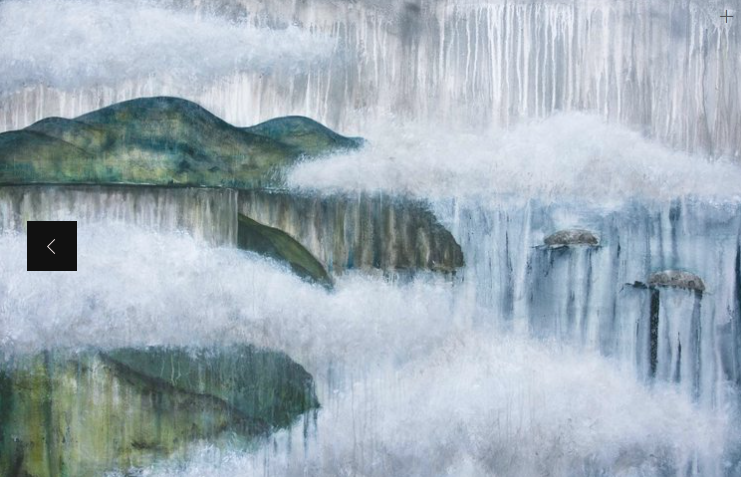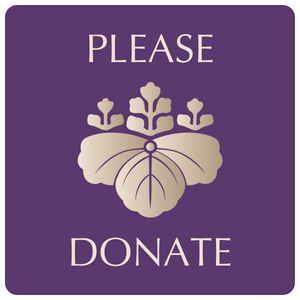ZPI encourages reflections from retreat participants, staff, members & others touched by our work and doing similar work from around the world, as part of the practice of bearing witness. Lisa Gakyo Schaewe artist, counselor and practitioner at Eon Zen Center in Boulder, Colorado USA, shares a story about the role creation and art plays in connecting one’s self back to a soul’s purpose. This is a story for artists and non-artists a like, a message beckoning for all who feel the drive to create to do so with passion, dedication and, most importantly, immediacy.
There are times when simply being present with a person, bearing witness to his or her humanity and suffering, and providing an opportunity to make contact with art materials can open a door to the subtle communication of the most profound and intimate messages.
Roland was close to the end of life when we met. Just a few months after retiring early from a successful career in the design field to concentrate on his own artwork, he had been diagnosed with ALS, or Lou Gehrig’s disease.
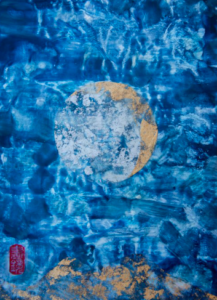 I was an art therapist doing hospice work when our paths crossed. Since his arrival at the care center Roland had declined most of the assistance and services offered. A parade of chaplains, doctors, nurses, aids and volunteers made earnest attempts to engage him and each had been abruptly dismissed. In his anger and anguish, he was inaccessible—constructing emotional barricades around himself that no one in his family or on the treatment team could penetrate.
I was an art therapist doing hospice work when our paths crossed. Since his arrival at the care center Roland had declined most of the assistance and services offered. A parade of chaplains, doctors, nurses, aids and volunteers made earnest attempts to engage him and each had been abruptly dismissed. In his anger and anguish, he was inaccessible—constructing emotional barricades around himself that no one in his family or on the treatment team could penetrate.
During my first visit the nurse on duty explained that Roland had been “some kind of artist.” She told me that his illness had progressed at a devastating pace and in just a few short months it had left him unable to speak or move anything but the thumb and first finger of his right hand.
A volunteer escorted me into Roland’s room and in a dizzying flurry of motion and sound, she jerked open the window shades, turned on a fan, and adjusted his pillows. She introduced me in a loud voice, speaking slowly and addressing him as if he were simple minded or hard of hearing. She tugged briskly on his blanket to smooth it before blowing out of the room. Waiting for the door to close, I stood a few feet away from him breathing deeply, feeling my way into the space and quietly taking in my surroundings.
Roland lay there shivering and squinting in the sunlight. His neck was awkwardly bent and his head sank deeply into the freshly fluffed pillow that looked as if it was about to consume him. I softly asked if he had difficulty hearing and he waved his fingers to gesture “no.” I asked if he knew why the volunteer had been yelling and he responded slowly and with great effort by straightening his middle finger. “So, I see you can use three fingers.” Seeing a spark of light in his eye, I moved closer and asked if it would be all right if I sat down at the edge of his bed.
Even in his depleted state, Roland was an elegant figure: dignified, intelligent and refined, with a razor sharp sense of humor. I would later learn when I saw an album with photos of his paintings and sculptures, that he was extremely talented as well. When his strength was up, he was able to write brief comments and questions on the white legal pad that I would hold steadily at a certain angle, leaning it against my knee for support as I sat next to him.
Roland had lists of questions about my profession, artwork, and home life. At first I tried to redirect him, encouraging him to express more about himself; his thoughts, feelings and his concerns. But what ensued instead was an exhaustive discussion about what interested us both most: art and the role of art making in an artist’s life. This developed into what I still consider the conversation of a lifetime.
Roland and I had chosen careers that involved engaging with creative process, which we found simultaneously rewarding 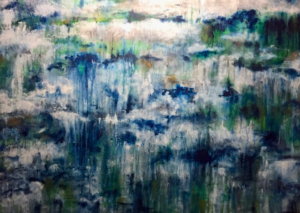 and lacking. We shared a longing to express our authentic, innermost selves in a way that invited deep inquiry, intimacy and held meaning. Both of us had managed to integrate our passions into a career, yet there was a polarization between our personal and professional creative lives that produced gaps in the emotional and spiritual elements of our art making. Shawn McNiff, in his book Art as Medicine, wrote that we can lose contact with the soul’s “movements within our daily lives.” Art making enhances awareness of these movements of the soul, making them visible. For Roland, as for me, that aspect of the process had fallen through the cracks. In our professional work we both needed to focus attention entirely on our clients’ needs. At the end of the day we were too busy or exhausted to make art for ourselves. This was the conscious compromise we both had made: to postpone our own need to make art- our soul’s purpose- for some other point in time that we expected, envisioned, or at least hoped would someday arrive and welcome us with good lighting, fresh ideas, and shelves of the finest quality materials. An art studio version of heaven rewarding us for all our hard work and sacrifice.
and lacking. We shared a longing to express our authentic, innermost selves in a way that invited deep inquiry, intimacy and held meaning. Both of us had managed to integrate our passions into a career, yet there was a polarization between our personal and professional creative lives that produced gaps in the emotional and spiritual elements of our art making. Shawn McNiff, in his book Art as Medicine, wrote that we can lose contact with the soul’s “movements within our daily lives.” Art making enhances awareness of these movements of the soul, making them visible. For Roland, as for me, that aspect of the process had fallen through the cracks. In our professional work we both needed to focus attention entirely on our clients’ needs. At the end of the day we were too busy or exhausted to make art for ourselves. This was the conscious compromise we both had made: to postpone our own need to make art- our soul’s purpose- for some other point in time that we expected, envisioned, or at least hoped would someday arrive and welcome us with good lighting, fresh ideas, and shelves of the finest quality materials. An art studio version of heaven rewarding us for all our hard work and sacrifice.
Our conversations covered all of the big existential points, always circling back to two interrelated and inseparable themes: the questions of what it means to be an artist and the capacity for art to create meaning in one’s life. We explored our common experiences of what it is like to give oneself away, surrendering to a painting or sculpture and what it feels like to receive back from it a sense of accomplishment, peace, and connection to something bigger than ourselves. In one of my favorite therapy books, Art and Soul: Reflections on an artistic psychology, Bruce Moon wrote, “Making art is making soul . . . When the arts are regarded from a soul viewpoint their work is made sacred.” Roland and I shared a sense of wonder in the creative process as a sacred path of discovery as well as a reminder that we were more than what my teacher John Daido Loori, Roshi often referred to as “the bag of skin.”
As weeks went by, Roland became weaker and no longer had the vigor or control needed to hold a pen and write. I still visited regularly and told him about the series of paintings I hoped to finish someday. Roland was withdrawing from a life that seemed so incomplete. Barely visible beneath the folds of the sheets, I imagined him floating down a stream like a leaf spinning in the current and smashing against exposed stones and branches on his way to the sea.
He once mentioned the brand of modeling clay he used in the early stages of developing a sculpture. I brought a lump of it with me the next time I went to see him. Working it in my hands until the consistency became soft and pliable, I held it close to his face so he could take in the oily scent. I pressed the clay firmly into his palm and wrapped his stiffened fingers around it tightly to let him feel it’s texture and warmth. I placed my other hand on the delicate blade of his shoulder as tears appeared and filled his eyes, remaining with him until the sky grew dark and the evening shift arrived for work. I cried the whole drive home. It was the last time I would see him. When I returned a few days later, the nurse told me he had passed away that night, with the lump of clay still nestled in his hand.
Roland wanted his story shared. He hoped that articulating his sacrifice would serve as a reminder for others to honor the essential role of art making in an artist’s life by not delaying or denying our engagement in creative process, by not succumbing to obstacles when they appear, and by letting the life-affirming, soul-rescuing, vital force of generative art open up, pour out, and flow forth as an offering to ourselves and to the world.
About the Author:
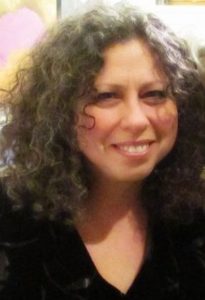 Lisa Gakyo Schaewe is an artist and a counselor and art psychotherapist in private practice. After teaching at Naropa University from 2002-2017, she currently teaches The Role of Art in Healing in the Integrative Health program at Red Rocks Community College. She facilitates Mindfulness Based Stress Reduction classes in Boulder County and Mind-Body Resiliency and Reconnection workshops in the Service to the Armed Forces program and provides Disaster Mental Health for the American Red Cross. She began Zen practice in 1990 with John Daido Loori, Roshi at Zen Mountain Monastery and studies now with Paul Gyodo Agostinelli, Sensei of Eon Zen Center.
Lisa Gakyo Schaewe is an artist and a counselor and art psychotherapist in private practice. After teaching at Naropa University from 2002-2017, she currently teaches The Role of Art in Healing in the Integrative Health program at Red Rocks Community College. She facilitates Mindfulness Based Stress Reduction classes in Boulder County and Mind-Body Resiliency and Reconnection workshops in the Service to the Armed Forces program and provides Disaster Mental Health for the American Red Cross. She began Zen practice in 1990 with John Daido Loori, Roshi at Zen Mountain Monastery and studies now with Paul Gyodo Agostinelli, Sensei of Eon Zen Center.

